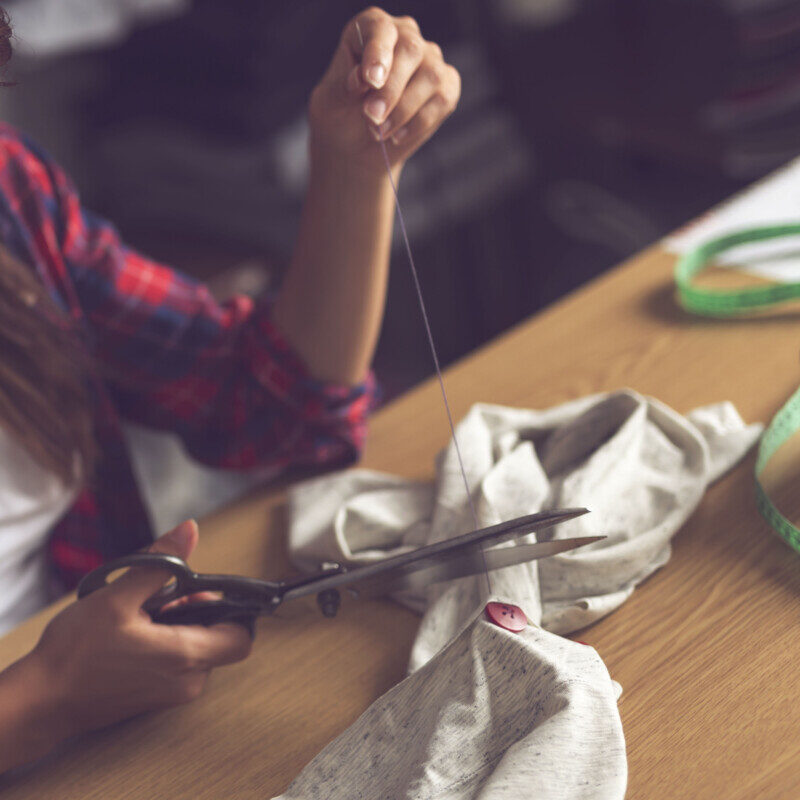Sewing homemade projects sometimes carry a rep. that the result will pale in comparison to those made by designers or sold in stores. What if I told you there’s a whole bundle of tips and tricks for designing garments that look just as good or better than those sewn professionally? Often, attention to detail and just a little extra time can transform the outcome of a project dramatically.
Read the tips below to make your home-sewn garments look so good they could pass for designer items!
1. But first, details.

Details first: add details like rhinestones, brooches, feathers, and buttons to pattern pieces before sewing major seams together when possible. Fewer pieces and weight to work with makes it easier to add details without interference or complications.
2. Hold it down.

Use pattern weights to hold the pattern down on top of the fabric to avoid irreversible holes or snags created by pins. You can also use Wonder Clips during construction to avoid the same issue.
Recommended Pattern Weights
- Dritz Pink Pattern Weights$16.98★ ★ ★ ★ ★(0 reviews)
- Dritz Blue Pattern Weights$16.98★ ★ ★ ★ ★(0 reviews)
- Dritz Green Pattern Weights$16.98★ ★ ★ ★ ★(0 reviews)
3. Baste and tack it.

Add temporary basting or tacking stitches to keep the fabric in place to avoid fabric slippage when sewing. It also saves time down the road.
4. Covered in pearls.

Use trims and embellishments galore to up the appeal on your final products. Hand sewn jewels and beading done with care are common features found throughout designer garments that will make your garments look exquisite.
Recommended Garment Details
- Black Marabou Feather Scarf$5.94★ ★ ★ ★ ★(0 reviews)
- Vintage Pearl and White Iris Beaded and Sequins Applique with Crystal Rhinestone Center – 8.25″ x…$9.94★ ★ ★ ★ ★(0 reviews)
- Fancy Silver Beaded Rhinestone Panel on a Nude Mesh – 37.5″ x 19″$399.99★ ★ ★ ★ ★(0 reviews)
- Black/Gunmetal Beaded Rhinestone Neck Applique$59.94★ ★ ★ ★ ★(0 reviews)
- Vintage Swarovski Crystal Rhinestones and Silver Metal Dress Trim Ornament – 0.875″ x 2.625″
$8.94$7.15★ ★ ★ ★ ★(0 reviews)
5. Press to impress!

Press seam-by-seam as you sew, using pressing tools to get tricky spots and to set the seams into place, then iron the final product really well. Start by ironing the details first, working your way inward to the body of the garment so that no areas are neglected.
Recommended Pressing Tools
- Dritz Green and Red Plaid Dressmakers Ham$11.94★ ★ ★ ★ ★(0 reviews)
- The Mighty Steam Iron$36.94★ ★ ★ ★ ★(0 reviews)
- Dritz Ironing Sleeve Board$65.98★ ★ ★ ★ ★(0 reviews)
- Dritz Button Gauge & Point Turner$3.49★ ★ ★ ★ ★(0 reviews)
- Nifty Notions Gray Wool Dryer Balls – Pack of 3$15.99★ ★ ★ ★ ★(0 reviews)
6. Tame the mane.

An unruly collar is a recipe for disaster. Always under-stitch collars and facings to keep them in place.
Recommended Interfacings
- White Cotton Buckram Stiffener$5.99★ ★ ★ ★ ★(0 reviews)
- Off-White Weft Fusible Interfacing$2.99★ ★ ★ ★ ★(0 reviews)
- Egret Polyester Stiffener$4.99★ ★ ★ ★ ★(0 reviews)
- Fusible Horsehair Interfacing Canvas Fabric$15.99★ ★ ★ ★ ★(0 reviews)
- White Lightweight Interlining or Stiffener
$9.99$5.99★ ★ ★ ★ ★(0 reviews)
7. Use stay-stitching.

Stay-stitching prevents the fabric from stretching out while being sewn; apply it to curved areas or bias.
8. Good quality shows.

When selecting fabric, trims, closures, etc. for projects, use high-quality materials for the best results. Inspect fabrics before you purchase them (or alter them if you’ve purchased them online) to make sure that they’re free of snags and stains.
9. Bigger is better.

Use wide elastic and casings to add to the overall quality of the finished product. Make sure that the elastic is sewn close to the casing or sewn directly onto it to avoid twisting.
10. Finish it off.

Finish all seam allowances, trimming them down with fabric shears to reduce bulk. We recommend serging your edges for the best results or using a french seam or a bias bound seam for any unlined garments.
Recommended Cutting Supplies
- Fiskars Titanium No.5 Scissor by The Arthritis Foundation
$21.99$17.59★ ★ ★ ★ ★(0 reviews) - Sullivan’s Silver Heirloom 3.5″ Scissor Pendant$59.99★ ★ ★ ★ ★(0 reviews)
- Gingher Knife Edge Thread Snippers – 4.5″$32.98★ ★ ★ ★ ★(0 reviews)
- Gingher Knife Edge Dressmaker Shears$49.98★ ★ ★ ★ ★(0 reviews)
- Gingher Left Hand Dressmaker Shears with Sheath – 8″
$49.98$39.98★ ★ ★ ★ ★(0 reviews)
11. Don’t skimp on the fabric.

Sew wider hems and cuffs. This adds weight to the garment so that it hangs nicely and presents a nicer overall look.
12. Don’t forget to cover-stitch knit.

Cover stitching adds a decorative finish that is also flexible, so you’ll likely find cover-stitching on knits – as they tend to offer stretch. You can also achieve the cover stitched look by using the double needle stitch on your sewing machine.
13. Check and double check your accuracy.

When cutting fabric or making pattern markings with a marking tool, double-check that all of your work is accurate to avoid finishing your project with wonky results. Don’t forget to double-check that grain, pattern alignment/placement, and nap placement (reference our sewing terms dictionary for help if needed) to ensure that they’re properly positioned.
14. Know your tools

Know what type of fabric you’re working with, and how to use your tools for the best results. Check that your sewing machine is properly adjusted and that you have a good understanding of how to use your tools to best benefit your projects.
15. Prototype it!

There’s no shame in making a prototype from muslin. Tweak any areas that aren’t fitting, sitting, or coming together as well as you’d like so you can move to your final product and fabric choice with confidence.
16. Plan ahead.

Make a schedule when sewing a project to stay organized and on track so that you don’t find yourself in a bind for time. Having a plan will allow you to take your time at each step.
17. Trim it up!

Snip any loose threads created by your sewing machine or from hand stitching to get a clean and high-end result.
18. A perfect fit.

Do your research and check out our blog post about bust fittings to learn how to sew garments that fit well and how to correct any fit issues that may be encountered. Your prototype will come in handy here. If you notice fit issues with length or sizing, you can address those before moving to your final product.
19. Think & Pre-Shrink

Launder any fabrics (including interfacings) as directed before sewing to avoid shrinkage after sewing your garment.
20. The prints are aligning.

If you’re sewing with a patterned fabric, make sure the pattern pieces line up accordingly so that they match.
21. Let’s face it!

Adding seam tape or facings to areas that undergo high stress is a great way to keep those areas intact during use.
22. Keep it sleek.

Use invisible zippers when possible for a discrete yet functional closure, allowing the garment to take the spotlight.
23. Get a crisp finish.

Apply top-stitching around areas like necklines and hems to achieve a polished, clean look that also serves as a decorative finish.
24. Adjust your seam allowances.

Reduce ⅝” seam allowances to ¼” around collars, facings, waistbands, etc. to decrease bulky finishes and create smoother seams.
25. Keep it clean-cut.

Precise and cleanly cut pattern pieces increase accuracy and a stronger presentation overall. Make sure that your tools are of good quality and sharpened well.
26. The bottom line.

Press your commercial pattern flat, then cut pieces to their cutting line for the best results.
27. Stay organized & in control.

Keep all notions needed for your current project in a specific location for easy reference, so when it’s time to sew you have everything in one central location. This will make it easy to pinpoint any missing notions or major key elements before you start your project.
28. One & done.

Cut and mark all pieces in one sitting and place those with your notions so that everything continues to stay organized, and in one place leaving little to no room for errors.
29. Finish strong.

Any finishes that can be seen on the outside of the garment need to be even, secure and done with great attention to detail. Any uneven stitches, loose buttons, or crooked trim will take away from your final result and can be pretty easily avoided.
30. Showcase your work.

Once you’ve completed your piece, you should style it with other pieces that are as high quality as the piece you’ve created to showcase its quality.
